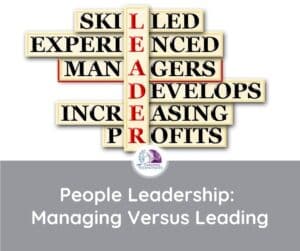Giving Feedback has always been a topic of great discussion in global leadership development. And there is a good reason why: giving proper and constructive Feedback can provide greater awareness of development areas, improve one’s performance, and help people achieve far more.
What few people realize is that Feedback is an act of collaboration. If not, then it should not be considered Feedback.
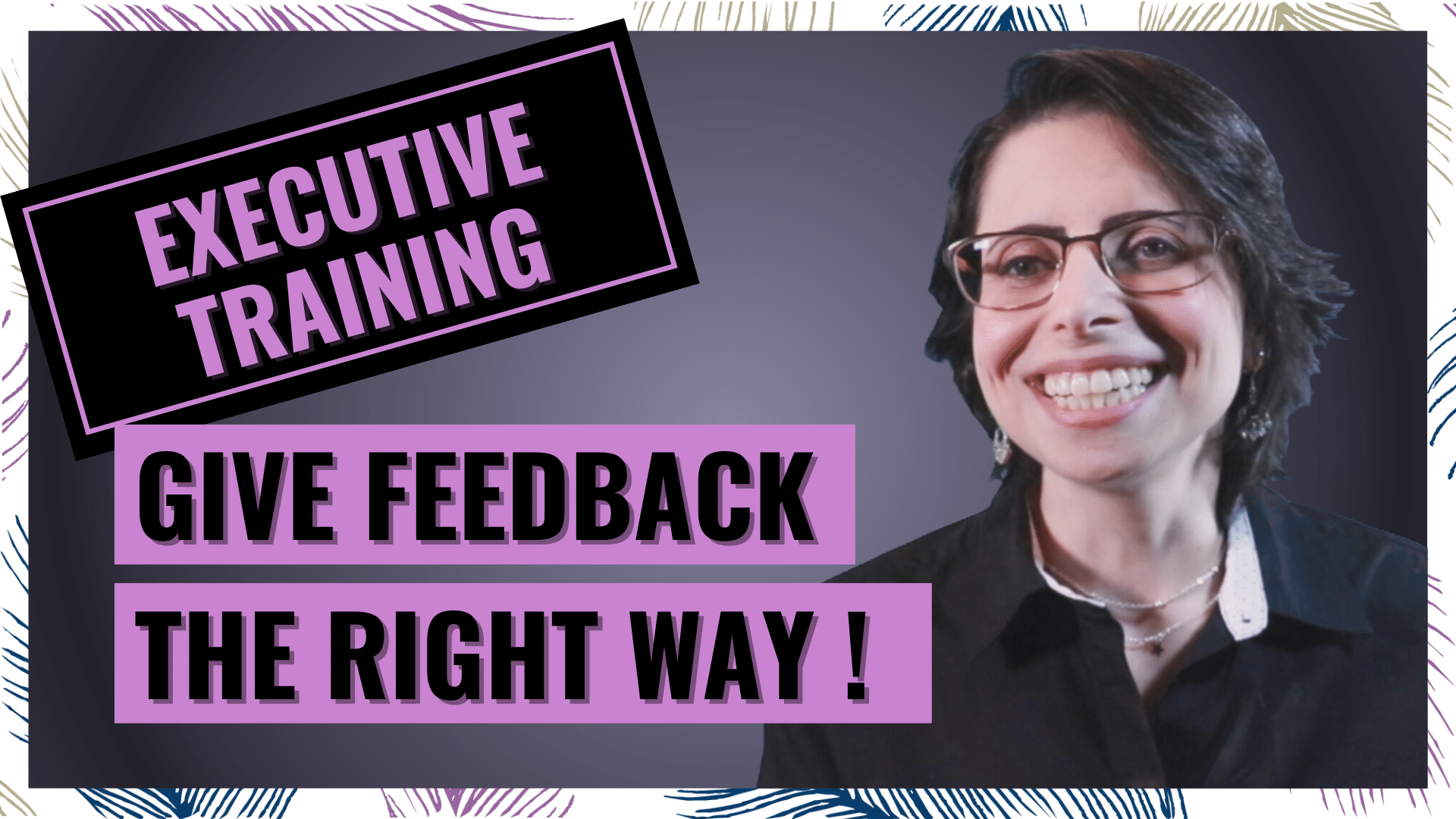
Do you prefer to read the full article? Go ahead!
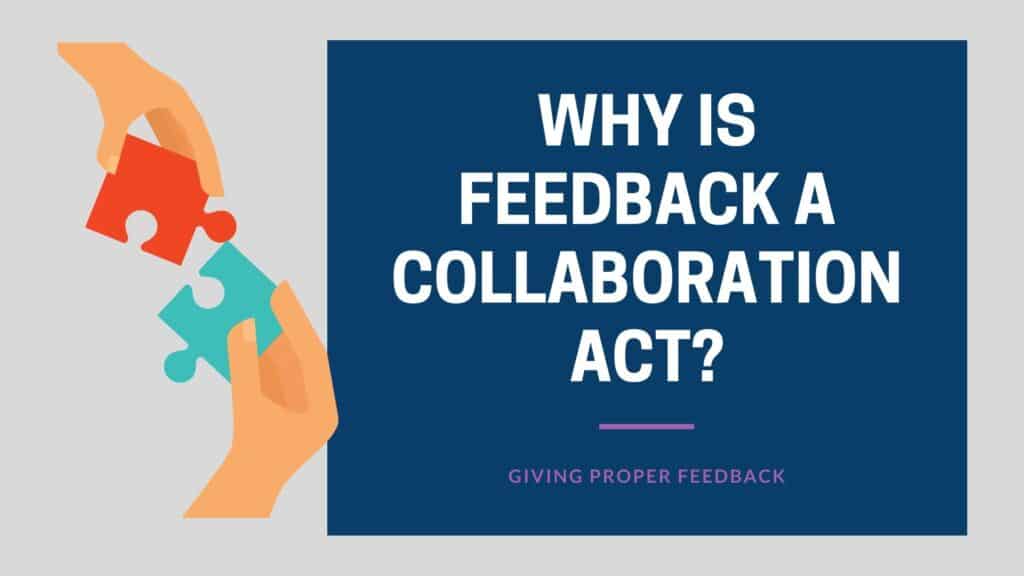
Why Is Feedback An Act Of Collaboration?
In the context of leadership, Feedback is an act of collaboration between:
- The subject of the Feedback, who will receive a constructive observation and/or suggestion of improvement about something that they have done
- The messenger of the Feedback, who will receive an indirect benefit from the improvement opportunity or enlightenment provided.
That’s right, you – as the leader – are not only providing Feedback just because you want to see a person develop. Although that might be a significant part of the reason, the leader’s main objective is to bring about a vision or a specific outcome.
This means that giving Feedback is an act of collaboration because when you do it properly you will receive something in return for helping that individual achieve more.
Helping people achieve better results by giving proper Feedback will help the leader accomplish what they want at the end of the day. Be it a goal, a better culture, a higher team performance, and so on.
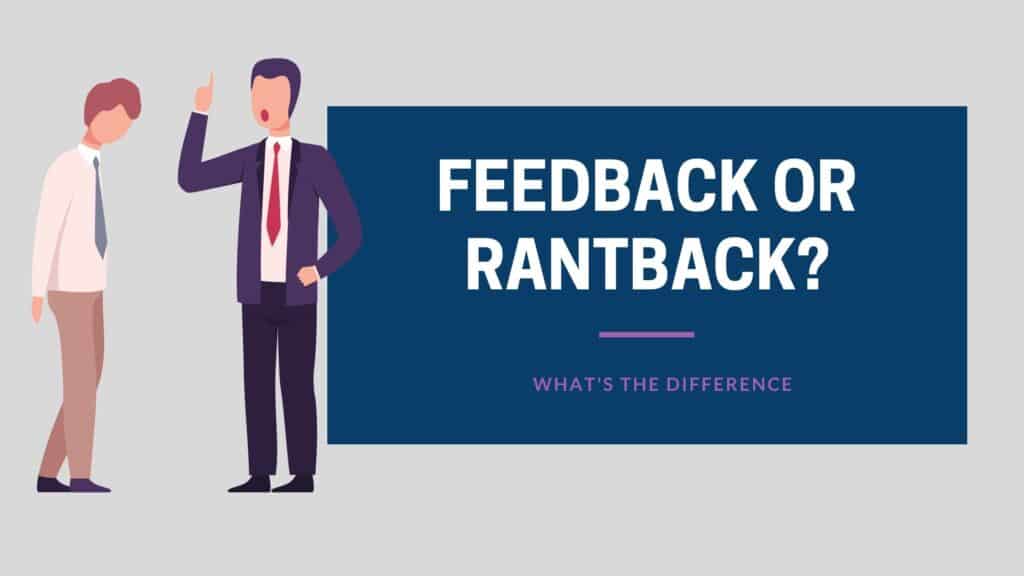
Feedback or Rantback
There I was, having an unforeseen issue with my personal documentation, which had to be addressed ASAP in the Social Security Office. So I drove to the closest office to get it resolved.
Not to my surprise, they were closed due to the Pandemic. They had a poster with online numbers to call and home-office hours.
My initial experience with them over the phone was not the best, and I was already pretty frustrated with the series of disastrous events that led me to have to go to the Social Security Office in the first place.
While waiting on the phone – for more than an hour, may I add – a recorded voice invited me to share my Feedback.
After the call, frustrated and tired, I wanted to leave Feedback. But I actually was ready to leave a “rantback” instead. My “rantback” would just be a projection of my own frustrations and anger instead of being helpful to the improvement and growth of that office.
This whole ordeal reminded me that we are not just global leaders when we are inside our corporate offices. We are global leaders. Period. We own it 24/7. We are not on and off of being global leaders.
My Feedback being a rantback would not help other green card holders like me to have a better experience. As a global leader, I have to think about my actions’ global and localized impact on other people and cultures.
Proper Feedback, with growth and improvement in mind, can make a difference. For both the giver and the taker. It’s an act of collaboration. And this sets us apart as a great global leader.

So, today, first, I want to remind you about the importance of knowing exactly why you are giving Feedback, and what you are getting back in return.
As I said, it’s an act of collaboration. You are getting something back in return. Before giving proper Feedback, clearly understand what it is.
Second, I want to share with you a framework for providing great Feedback, that will set you apart as a great global leader. Hope you like it and use it going forward.
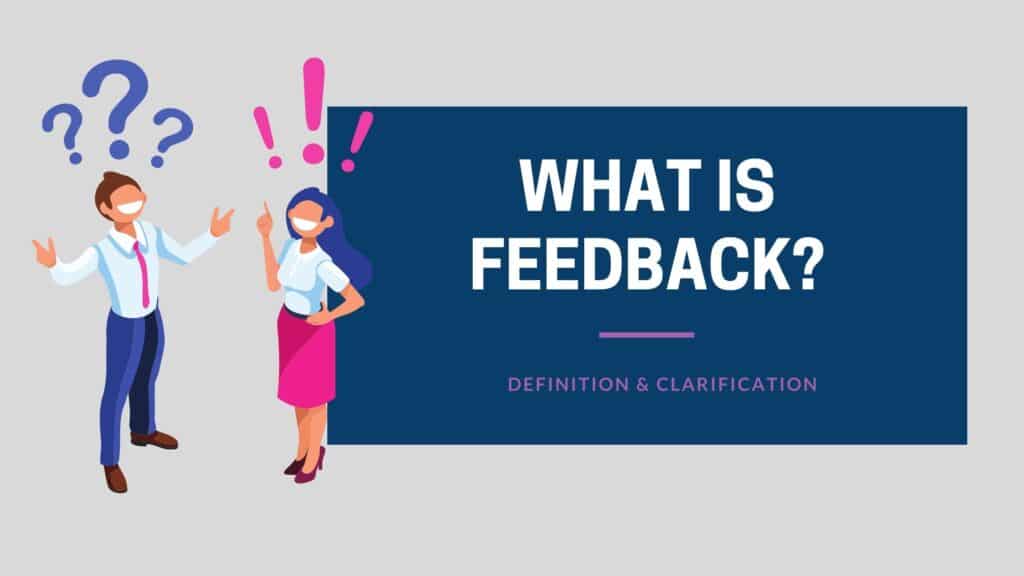
What Is Feedback
In the context of leadership, Feedback is the act of providing information about a reaction to or the performance of something or someone, with the intent of improving it or them. In return, their improvement will provide you a direct or indirect benefit.

Because it involves a giver and a taker of a message, it is considered a communication skill within the leadership context, and an act of collaboration, where all parties will have something to win.

6-Steps Framework For Effective Feedback
Coaching Expatriates® developed the 6-Steps Framework of Effective Feedback to help people who need structure and step-by-step process to do things in a more effective way.
STEP 1: Check Your Motives
As we mentioned before, knowing the reason why you decided to provide Feedback will hint you as to whether it will be a good Feedback or a rantback.
Suppose you are angry and want to vent it out by scolding your subject. Fine. Just know this will never be Feedback, and might not really accomplish much. Maybe even the opposite.
If you want to share “Feedback” because you want to feel superior, more educated, more studied, more traveled, or anything centered around how you want to feel, then it’s not Feedback either.
If the answer to “Why do I want to give Feedback” has something along the lines of “because we will both win if I share this information properly and respectfully,” then you might be on to some good Feedback.
STEP 2: Research Your Feedback Audience
Research and understand who the person or institution you are giving Feedback to is. How is their communication style? Are they from a High Context Culture or Low Context Culture? Is there a preferred method of learning and/or receiving messages?
If you don’t know and you have to give Feedback on the spot without the time to research your audience, ask them their preference before delivering your Feedback on step 4.
Listen, because it’s an act of collaboration, if the receiver of the Feedback is not open enough to receive it, there won’t be any collaboration, and your Feedback will fail.
So researching about your audience is a mere prerequisite to understanding how to make this collaboration work. As with any collaboration, you will need to understand what the other person wants and how they best consume information.
STEP 3: Prepare A Strong Feedback Content
Gurus can sugarcoat this all they want, but the truth to the matter is that either you are sharing what will be perceived as a criticism or a compliment. People see it as either “good” Feedback or “bad” Feedback. And it’s perceived this way because most people either compliment you or give you a rantback, when giving “Feedback.”
Feedback, however, is none of those 2 things. It’s not supposed to be either a compliment or a rant. Feedback is information, and must have a purpose. The purpose of helping the other person or institution – let’s call them Feedback subject – to improve and grow.
And by doing so, you’ll receive something in return. Be it a better service, an employee with higher performance, a better workplace & environment, or quicker progress towards a goal.
So Feedback content must be catered with this in mind: it’s shared information through an act of collaboration, where one side will grow, and the other side will achieve something in return by doing so.
Still, when sharing this information, you are highlighting either a strength or an improvement need in your Feedback. For each of these, you’ll have a different outline of content.
Let’s see an outline for each.
A) Constructive Feedback Outline For Improvements
- Share context: where and when did you specifically observe the situation you are referring to?
- Identify the problem: what was it, exactly, that didn’t work so well and why?
- Provide a specific solution: what could they have done precisely to make things work better?
- Clarify Desired Result: what would they achieve instead by using this proposed solution?
B) Constructive Feedback Outline For Strengths
- Share context: where and when did you specifically observe the situation you are referring to?
- Identify the strength: what was it, exactly, that did work so well and why?
- Provide alternative applications for that strength: where else could they apply the same thing and also obtain good results like this?
- Clarify Desired Result: what will they achieve if they continue to perform or behave like this?
When preparing your Feedback content ahead of time, use this outline to help you structure what you want to share.
Remember that since it’s an act of collaboration and you want to make sure all parties win, you want to structure your content in a constructive way. This means content that will help people gain specific information that will help them grow and develop.
While outlining content, you are not thinking yet about how you will deliver it. You are, first, putting together what information you want to convey.
STEP 4: Strategize Your Feedback Delivery
Before I talk about delivery, let me quickly discuss about asking permission.
Although feedback is indeed an act of collaboration by sharing improvement or strength information, because it touches personal matters and skills, it can be something delicate.
In most countries, feedback falls into the same category of unsolicited advice: unwanted. The act of asking permission is and act of stablishing the collaboration agreement. If you don’t have a permission, you don’t have collaboration. And if you don’t have collaboration, it’s not Feedback in the context we are sharing here.
This means that before delivering any feedback, we strongly recommend that you ask permission to share your feedback. You can be as formal as “Do you allow me to share a feedback?” or as informal as “Here’s my reaction. Are you interested in hearing it?”
There are many known Feedback delivery strategies out there. But they all boil down to 3 main methods:
The Sandwich Method starts the Feedback sharing a positive aspect of what the person did, then goes to the core of the development need or strength, then finalizes saying something good about the person, not necessarily related to what they did. Most borderline Low Context Cultures tend to use this method.
The Sugarcoated Method gives Feedback by sugarcoating the deficiency or strength to make it look acceptable or less faulty. A deficiency will appear less faulty, and strength will appear less positive. There are countries where complimenting people or giving strong positive Feedback may be a sign of your own weakness, so people tend to share positive Feedback using this method. Most High Context Cultures make heavy use of Sugarcoating method.
The Transparent Method gives Feedback by being straight to the point to the core of the content, without being aggressive or condescending. It can be either constructive or destructive, depending on how the content was structured. Most Low Context Cultures tend to use the Transparent method.
One very important point regarding Feedback delivery and global leaders is that each culture relies more on one type of delivery than others. For example, Latin countries tend to use the Sugarcoating Method more often than not. Conversely, Germans and Finns tend to use the Transparent Method more often than not. Americans are very famous for the Sandwich Method.
If you use the sugarcoating method in Germany, you will not do a proper job of providing Feedback, even if your Feedback was splendidly constructive and valuable. Because they will not put the right “weight” on the message. The contrary applies. Transparent methods, when used in Latin countries, often prompt a strong reaction. Employees often think they are about to get fired (or promoted) instead of putting the correct weight for the intended message.
Also, as a highlight, some cultures tend to use different delivery methods depending on the purpose. For example, using the transparent method for strengths and sugarcoating method for improvements. Or vice versa, or any other combination. It is also frequent to see different methods used for different genders. For example, in South Korea, it is often “ok” to use a transparent method for men but sugarcoating method for women instead, when in corporate settings.
Similarly, different personalities and their level of confidence and self-worth also affect how you should deliver your Feedback. If the person you are giving Feedback to already knows the content of the Feedback and they already lack confidence, it won’t make any good in this collaboration to talk too much about what went wrong. Help them gain more confidence by addressing the solution and results.
On the other hand, if the other person seems to be completely oblivious about what’s going on, and their level of confidence is not compatible with their performance level, you will need some extra time to raise their awareness. When, as a leader, you face cases like this, you’ll have to work extra hard on your content, to support all your observations in a way that do raise their awareness.
And that is why STEP 2 (knowing your audience) is so important. You need to understand your subject first so that you can choose the correct delivery method for your intended purpose of the collaboration.
Just know that choice of methods can be different in different places and may need to be adjusted according to local culture and personal preferences of the receiver end. So the more you know about your audience for Feedback and the culture they are inserted in, the better.
STEP 5: Get A Thermometer Check At The End
If your intention of giving Feedback was to help the subject improve and grow – as it should – you don’t want to skip this step. After you gave your Feedback, your next step is to probe reaction. The sole motive for doing this is because you want to get a thermometer feel of how that Feedback was received. This will help you improve your Feedback giving experience but will also help you address any misunderstandings.
You can ask things like:
- “what crossed your mind when I shared this information?”
- “How much of that resonated with you?”
- “How are you feeling about this?”
Remember: if the feedback subject is an introvert, or someone who needs some time to privately process information and situations, give them space if they respond “I have to think about it.” That makes step 6 even more important.
STEP 6: Agree On A Follow Up Action
They say information and knowledge are power, but that is not entirely correct. Information and knowledge become power only when you take action on them. The last step of any Feedback process is to agree on a follow-up for this conversation.
The follow-up – or next step – might be a formal plan with a deadline or simply a day for the next conversation on this topic. Make sure to agree on whatever you both define and write it down somewhere that will be accessible for both.
What you want to achieve with this step is to give proper space for your Feedback receiver to process all information and start taking action on it, but ensuring a proper closure after the’ve done it.
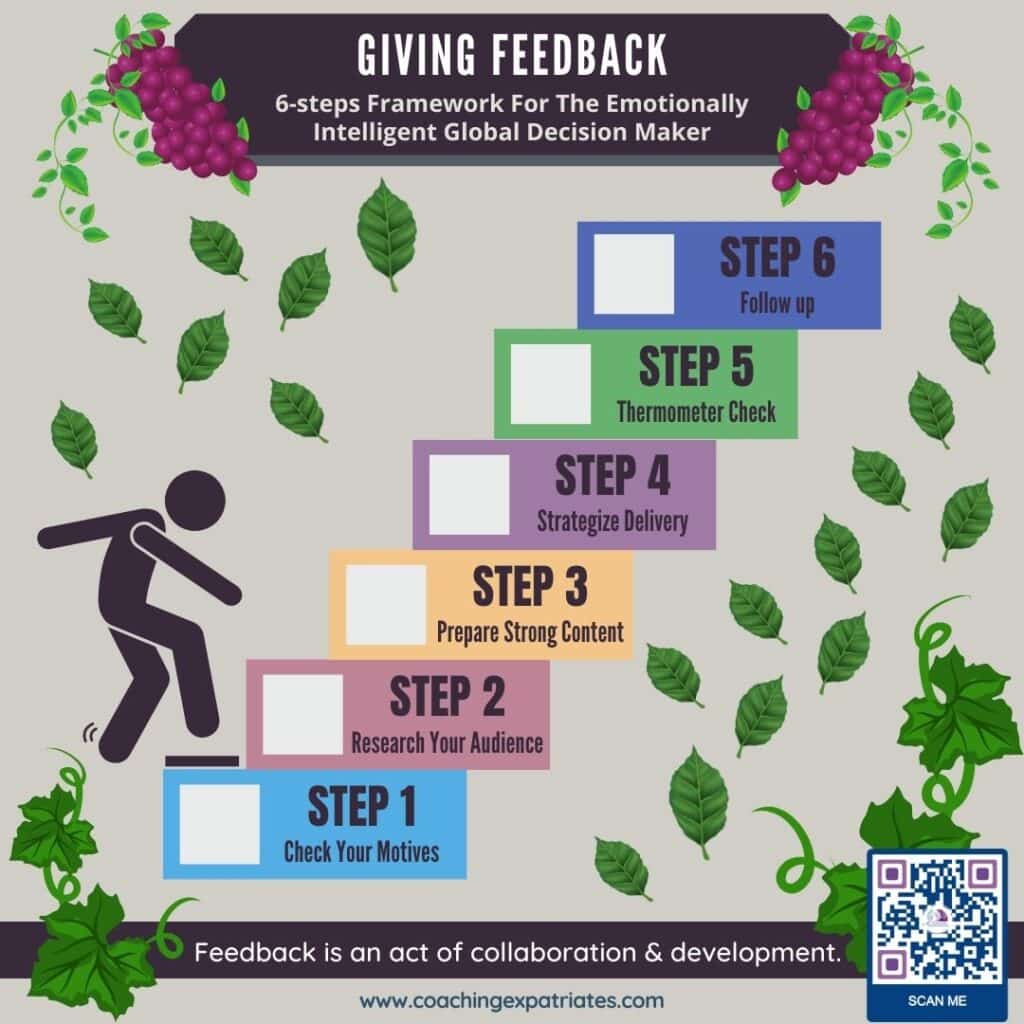
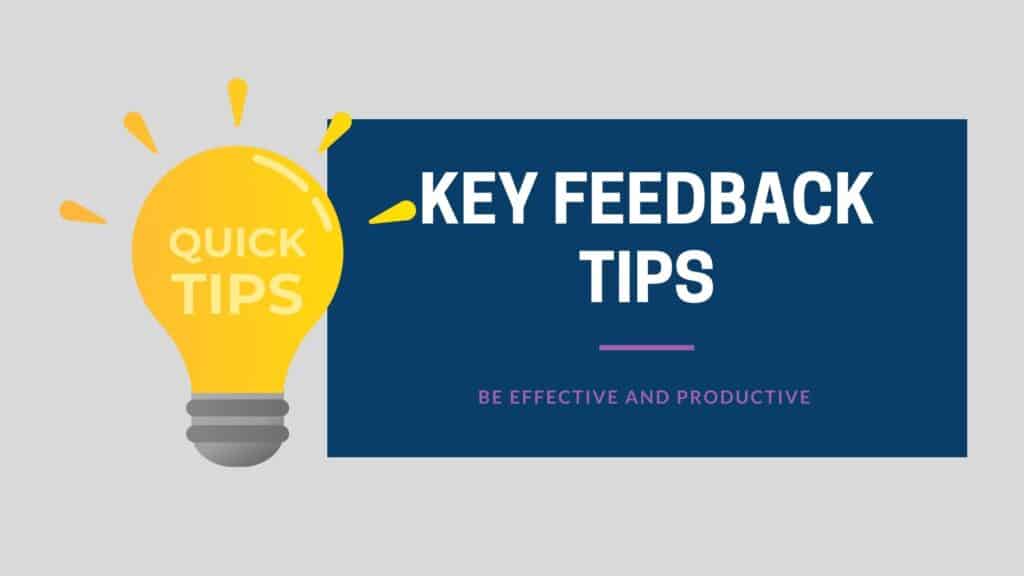
Key Tips For effective Feedback
I talked to 29 global leaders in various fields and leadership positions to create this round-up of key tips for effective Feedback. Here they are:
- Make giving proper & timely Feedback part of a regular activity of your personal branding
- Use Feedback with growth and development in mind
- Always be specific and provide constructive suggestions
- Do it in a safe and private space
- Always use “I” statements
- Don’t accumulate issues or situations to provide Feedback. Do it timely and one or two at a time.
- Focus on the Feedback topic only. If other points or topics come up during the meeting, ensure the other party, you will address them by scheduling another meeting later in the week to talk about it.
- Always remind your subject of Feedback that what you are saying is part of your perspective and might not be the universal truth
- Your Feedback is as strong and reliable as your trustworthiness; if you don’t yet have a trust bond with the other party, consider first creating this bond before sharing timely Feedback.
- Focusing on people’s shortcomings may only impair them. Try instead to focus on outcomes and what they can do to achieve them. In the outline, this reflects the “solution” and “results” portions.
- Giving Feedback is only one skill on the Manager Coaching Skills Toolkit. Try to learn all the skills in this toolkit by enrolling in executive leadership training, and your feedbacks will work 100-fold better
Some Feedback starters
When you want to say, “Can I give you some feedback?” say instead, “Here’s my reaction. Do you want to hear it?”
When you want to say “Good job!,” say instead, “Here are things that really worked for me.”
When you want to say, “Here’s what you should do,” say this instead, “Here’s what I would do in a similar situation.”
When you are burning to say, “Here’s where you need to improve,” try this instead: “Here’s what worked best for me in the past in a similar situation, and here’s why.”
When you want to say, “That didn’t really work,” consider saying instead, “When you did this, I felt this way. Is that what you were aiming for?”
Feedback Study Case
I once worked for a group that always connected Feedback with something wrong. If you did something wrong or not as well as expected, they gave “Feedback,” kindly referred to in the corridors as “rantback.” That’s not Feedback.
As we saw. Feedback should be a support system for the growth of everyone involved, and as such, it needs to be constructive and with a specific result in mind.
At the beginning of my career, one of my first professional Feedback given to me was, “you smile too much.” That confounded me a lot. What does that even mean? In what context? Yes, that felt very confusing. For many years that one Feedback I got was a tremendous burden for me, and I thought I should not smile at all. I thought I should be as tough as a rock.
Based on our 6-Step Feedback Framework, let’s see better Feedback content than just saying “you smile too much.”
“When you talked with Bob yesterday, you smiled a lot at the initial portion of the meeting. Bob is a data-driven global leader who needs data and facts to make decisions. You tried to create rapport through friendly body language, gestures, and smiles, which will make you look unreliable instead of friendly to people like Bob.” (problem identification)
“That approach would work well with Berta, who is a Connected Global Leader. What works well for me when talking to Bob is showing him all the details, data, and facts first. Then engage him in analyzing those things with you. Then you can use your strength of creating strong rapport through friendly body language, gestures, and smiles if you want.” (specific solution)
“This way, you will be perceived in a much more reliable and effective way by Bob, which might help you deliver your business case with a better response from Bob.” (desired result)
Does this mean that, now that you learn this Feedback structure, your Feedback is more valid, right, or correct? No. It just means your Feedback is more useful for growth and collaboration. Your Feedback, after all, is still just your own opinion about a topic. But whatever your opinion is, you are making it more constructive.
Whenever you give Feedback in life (professionally or otherwise), my strong suggestion is always to think about the subject’s improvement. “How can I help this person improve?” Don’t share any Feedback if you can’t give a specific solution with a clear desired result. If you are not up for the help, don’t be a burden.
As you saw in my example, you can confuse your employees and sway them from improving in the right direction. I, for one, never needed fewer smiles. I needed smiles at the right time. But ended up being a rock for many years.

Final Remarks
When we all remember that people receiving Feedback is just like us – get hurt just like us, have gremlins just like us, and want to be happy – we will focus more often on giving proper constructive Feedback using this framework.
After all, it’s not just about being more effective. It’s also about being decent, respectful, and with collaboration in mind.
If you enjoyed this post, consider subscribing to our newsletter using the form below. We focus on providing good content to global leaders who want to make impactful business decisions and become more inclusive and influential. We know your inbox is sacred, so we email just once per week, and we never sell your information. Trust is the basis of global leadership, and we fully honor it.




